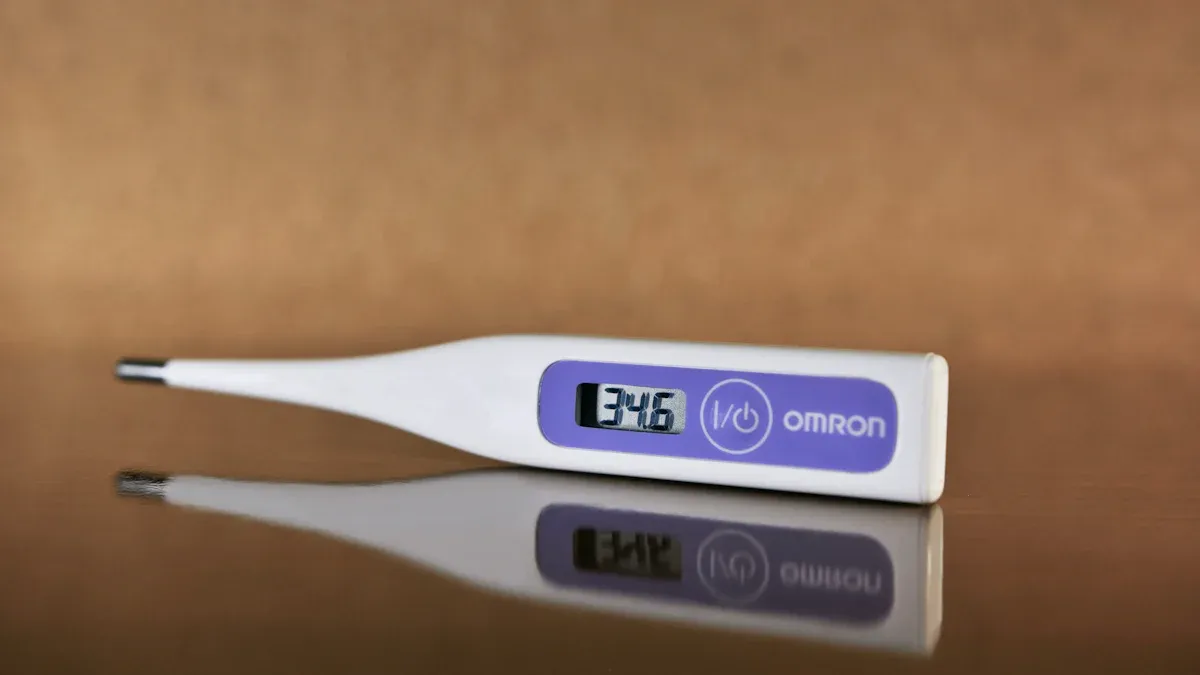
You rely on medical robots for critical patient care, where every second counts. When power interruptions occur, backup batteries maintain essential functions and prevent downtime. Hot-swappable batteries let you change batteries quickly, without shutting down robots, so you avoid data loss and keep operations running. Effective thermal management safeguards battery safety and reliability.
Hot-swappable batteries enable seamless battery changes for continuous operation.
Backup batteries protect patient care during outages and emergencies.
Seamless battery swaps prevent interruptions and data loss in healthcare environments.
Key Takeaways
Backup batteries are essential for maintaining patient care during power interruptions. Choose batteries with integrated management systems for enhanced safety.
Hot-swappable battery systems allow for quick battery changes without shutting down medical robots. This feature is crucial for continuous operation and patient safety.
Effective thermal management is vital for battery reliability. Implement cooling solutions and monitor temperatures to prevent overheating and extend battery life.
Part 1: Backup Batteries in Medical Robots
1.1 Role of Backup Batteries
You depend on backup batteries to keep medical robots running during power interruptions. These batteries protect patient safety by ensuring that critical systems never lose power. Advanced battery management systems (BMS) in medical robots provide accurate state of charge (SOC) and state of health (SOH) calculations. This technology prevents overcharging and over-discharging, which reduces the risk of short circuits and fires. Reliable backup batteries also maintain data integrity, so you never lose essential patient information during battery replacement or outages.
Tip: Always select backup batteries with integrated BMS for enhanced safety and reliability. Learn more about BMS.
The average lifespan of backup batteries varies by chemistry and application. The table below summarizes typical lifespans for batteries used in medical robots:
Battery Type | Average Lifespan |
|---|---|
Lithium-ion medical batteries | 5-10 years |
Nickel-metal hydride batteries | 3-5 years |
Alkaline medical batteries | 1-2 years |
Silver-oxide medical batteries | 2-5 years |
Zinc-air medical batteries | 6-12 months |
1.2 Medical Cart Batteries Applications
Medical cart batteries support the mobility and continuous operation of medical robots in clinical settings. You use these batteries to power carts that transport equipment, medication, and devices throughout hospitals. The right battery replacement strategy ensures that your carts remain operational around the clock.
Battery Type | Advantages | Applications |
|---|---|---|
Lithium Iron Phosphate (LiFePO4) | Improved safety, longer cycle life, faster charge rates | Healthcare environments |
Lithium Cobalt Oxide (LiCoO2) | High energy density, longer runtime for size and weight | Laptops, mobile devices |
Sealed Lead Acid (SLA) | Historically used, less common today | Older medical carts, UPS |
You benefit from rechargeable medical cart batteries, which allow for scheduled battery replacement and recharging. Battery swapping technology lets you exchange batteries quickly, supporting 24/7 operations. The following features enhance your workflow:
Uninterrupted power supply for medical robots
Enhanced mobility for medical carts
Hot-swapping capability for seamless battery replacement
Ergonomic design for easy handling
By choosing the right medical cart batteries and battery replacement methods, you ensure that your medical robots deliver consistent performance and patient care. Explore lithium battery chemistries for optimal results in your applications.
Part 2: Hot-Swappable Batteries Systems

2.1 Hot-Swappable Design
You rely on hot-swappable battery systems to maintain continuous operation in medical robots. These systems allow you to replace batteries without powering down your devices. This feature is essential for patient safety, especially during emergency procedures. Hot-swap technology ensures that your robots never lose power, even when you change batteries in critical situations.
Key design features of hot-swappable battery systems include:
Internal bridge battery or capacitor keeps your robot powered during battery replacement.
Battery management system (BMS) monitors battery status and manages safe power transitions. [Internal link: BMS]
Smart firmware and advanced power handling prevent system crashes during swaps.
Secure battery lock and quick-release mechanism enable fast battery changes, even in high-pressure environments.
Tip: Choose hot-swappable battery systems with integrated BMS and smart firmware to maximize battery performance and patient safety.
You see these design features in medical robots used in emergency departments, surgical suites, and mobile medical carts. Lithium battery chemistries, such as lithium iron phosphate (LiFePO4) and lithium cobalt oxide (LiCoO2), offer high energy density and long cycle life for hot-swappable applications. [Internal link: lithium battery chemistries]
2.2 Safety Protocols
You must follow strict safety protocols when using hot-swappable batteries in medical robots. Regulatory standards set clear guidelines to protect patient safety and ensure reliable battery performance. The table below summarizes key standards for hot-swappable battery systems:
Standard | Description |
|---|---|
IEC 60601 series | Medical electrical equipment safety standards |
IEC 62304 | Software lifecycle processes for medical device software |
ISO 14971 | Risk management application for medical devices |
IEC 62366 | Usability engineering application for medical devices |
ISO 13485 | Quality management requirements for medical devices |
IEC 81001-5-1 | Safety, effectiveness, and security for health software and IT |
IEC 62133-2 | Safety requirements for lithium batteries in portable applications |
IEC 60086-4 | Safety of lithium batteries in primary batteries |
You must train your staff to handle hot-swappable batteries safely. Always check battery status before swapping. Use only approved battery types to avoid compatibility issues. Follow manufacturer guidelines for battery replacement and disposal. These protocols help you prevent accidents, protect patient safety, and maintain optimal battery performance.
Note: Regular safety audits and compliance checks ensure your hot-swappable battery systems meet industry standards.
2.3 Operational Efficiency
Hot-swappable battery systems improve operational efficiency in medical robots. You can swap batteries quickly, keeping your devices running without interruption. This capability is vital during emergency response, where every second matters for patient safety.
Hot-swappable batteries provide continuous power, preventing disruptions in patient care.
You switch batteries without powering down, maintaining access to critical devices and patient data.
Fast recharge times (as low as 2.5 hours) keep your robots operational throughout long shifts.
Lightweight battery design reduces physical strain on your staff, improving mobility and workflow.
You see the impact of hot-swappable battery systems in emergency departments, intensive care units, and mobile medical carts. These systems support rapid battery changes during emergencies, such as power outages or urgent patient transfers. You avoid downtime, protect patient safety, and optimize battery performance.
Aspect | Description |
|---|---|
Initial Investment | High upfront capital investment for hot-swappable battery systems |
Operational Efficiency | Zero downtime leads to continuous productivity and reduced costs |
Eco-Friendly Power | Sustainable systems may lower long-term operational costs |
You must consider the cost implications of hot-swappable battery systems. High initial capital costs often exceed 1M€ for advanced medical robots. Yearly service agreements range from 8-10% of the capital cost. Low utilization rates can increase running costs, so you should evaluate your workflow and choose systems that match your operational needs.
Tip: Invest in hot-swappable battery systems with proven lithium battery chemistries for long-term reliability and sustainability.
Hot-swappable battery systems set the standard for uninterrupted patient care and emergency response in modern healthcare environments. You ensure patient safety, maximize battery performance, and achieve operational excellence by adopting these advanced technologies.
Part 3: Thermal Management for Batteries

3.1 Cooling Solutions
You need robust cooling solutions to maintain optimal temperature for batteries in medical robots. Effective cooling strategies protect battery health and ensure reliability in high-demand environments. You can choose from several cooling methods:
Air cooling uses natural or forced airflow to regulate battery temperature. This method suits applications where simplicity and low maintenance are priorities.
Liquid cooling circulates coolant to absorb heat from batteries. You achieve higher efficiency in environments with intense workloads, such as surgical robots and security systems.
Phase change materials absorb or release heat during phase transitions, stabilizing battery temperature. You benefit from passive thermal management in infrastructure and industrial robots.
Thermoelectric modules create a temperature difference when electric current is applied, supporting precise temperature control in advanced lithium battery packs.
You must select the right cooling solution based on your application scenario. Lithium battery chemistries, such as lithium iron phosphate (LiFePO4) and lithium cobalt oxide (LiCoO2), respond differently to cooling methods. [Internal link: lithium battery chemistries] You improve reliability and battery health by matching cooling strategies to your operational needs.
Tip: Integrate cooling solutions with your battery management system (BMS) for real-time temperature regulation and enhanced reliability. [Internal link: BMS]
You often compare passive and active cooling methods to optimize battery maintenance and reliability. The table below highlights their differences:
Cooling Method | Efficiency Characteristics | Complexity and Maintenance |
|---|---|---|
Passive Cooling | Uses natural heat dissipation; less efficient at extracting heat; efficiency varies with environment. | Simpler, lower maintenance, less expensive. |
Active Cooling | Uses external devices for heat regulation; extracts heat more efficiently. | More complex, consumes more energy, requires maintenance. |
You improve reliability and battery health by choosing the right cooling method for your batteries. You reduce downtime and extend battery life with proper battery maintenance and routine inspections.
3.2 Temperature Monitoring
You rely on advanced temperature monitoring technologies to safeguard batteries in medical robots. Accurate monitoring ensures reliability and supports predictive maintenance strategies. You use external temperature sensors and intelligent battery management systems to track battery temperature and prevent overheating.
Source | Description |
|---|---|
Predictive Monitoring System for Autonomous Mobile Robots Battery Management | This system includes external temperature sensors to monitor battery temperature, providing safety against potential combustion. |
How Operating Temperature Affects Lithium-Ion Batteries | Intelligent Battery Monitoring Systems (BMS) use temperature sensors to optimize battery performance across various conditions. |
Maximizing Robot Efficiency with Smart Battery Management Systems | Smart BMS integrates thermal control and monitors individual cells to enhance energy management in robots. |
You integrate these technologies into lithium battery packs for medical, robotics, and industrial applications. You improve reliability and battery health by using predictive maintenance strategies and routine inspections. You ensure batteries operate within safe temperature ranges, reducing the risk of failure and protecting patient care.
Note: Schedule routine inspections and battery maintenance to verify temperature sensor accuracy and system reliability.
You enhance battery maintenance by combining temperature monitoring with predictive maintenance strategies. You detect early signs of battery health decline and prevent unexpected failures.
3.3 Overheating Prevention
You must prevent battery overheating to maintain reliability and protect patient care. Overheating can damage batteries, reduce battery health, and compromise safety. Common causes include thermal management issues, overcharging, and short circuits. You address these risks with effective preventive measures.
Thermal management issues arise from ineffective cooling, leading to excessive heat and thermal runaway.
Overcharging causes heat buildup, risking battery integrity and reliability.
Short circuits result from handling errors or defects, causing rapid temperature rise and battery failure.
You implement preventive measures to reduce overheating risk and improve reliability:
Preventive Measure | Description |
|---|---|
Battery Management Systems (BMS) | Ensure proper monitoring and control of charging, discharging, and cell balancing. |
Mechanical Design | Protect batteries with robust casings to withstand impacts or punctures. |
Thermal Insulation | Incorporate materials that limit heat transfer between cells. |
Preventive Measure | Description |
|---|---|
Smart Charging Circuits | Automatically cut off power once the battery reaches full charge. |
Voltage Monitoring Systems | Ensure batteries operate within safe voltage ranges. |
Fail-Safe Mechanisms | Shut down operations if voltage thresholds are exceeded. |
Preventive Measure | Description |
|---|---|
Advanced Battery Technologies | Incorporate features that prevent overheating, safeguarding both the equipment and the patient. |
Heat Dissipation Design | Designed to dissipate heat efficiently, maintaining optimal operating temperatures. |
You improve reliability and battery health by combining these preventive measures with routine inspections and battery maintenance. You support predictive maintenance strategies to identify risks before they impact patient care. You ensure batteries deliver consistent performance in medical, robotics, and industrial sectors.
Tip: Use advanced lithium battery chemistries and integrate BMS for maximum reliability and safety in your medical robots.
You achieve optimal reliability and battery health by prioritizing battery maintenance, routine inspections, and predictive maintenance strategies. You protect patient care and extend the lifespan of your batteries with robust thermal management.
You ensure uninterrupted operation in medical robots by using backup and hot-swappable lithium battery packs. Regular maintenance supports safety and efficiency:
Identify issues early to keep batteries within safe parameters.
Prevent overcharging with smart charging circuits and voltage monitoring.
Meet strict regulatory standards for safety and innovation.
Latest Flexible Battery Type | Description |
|---|---|
Provide reliable energy storage for diverse applications. | |
Flexible Sodium-Ion Batteries | Offer cost-effective, abundant material alternatives. |
Stay informed about regulatory changes and advancements to maintain compliance and drive innovation in your medical robotics solutions.
FAQ
What factors impact battery life and longevity in medical robots?
You must consider lithium battery chemistry, operating temperature, and scheduled battery replacements. Strategic battery management and predictive maintenance extend battery life and longevity in medical robots.
How do you optimize battery replacement for continuous operation?
You implement autonomous battery-changing systems and predictive monitoring. Scheduled battery replacements and custom battery solutions from Large Power ensure uninterrupted workflow in robotics and industrial sectors.
How does predictive battery management improve reliability?
You use predictive analytics and BMS to monitor battery health. Predictive strategies help you schedule battery replacement, reduce downtime, and extend battery life in medical, security, and infrastructure applications.
Note: For custom lithium battery packs, visit Large Power Custom Battery Solution.
Lithium Battery Chemistry | Application Scenario | Longevity | Life Expectancy |
|---|---|---|---|
Lithium Iron Phosphate | Medical, robotics | High | 8-10 years |
Lithium Cobalt Oxide | Consumer electronics | Moderate | 5-7 years |
Lithium Manganese Oxide | Security systems | Moderate | 5-8 years |




